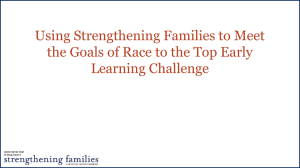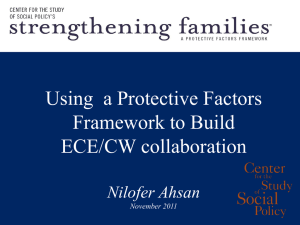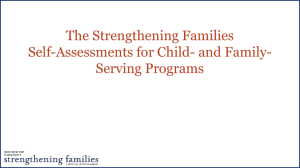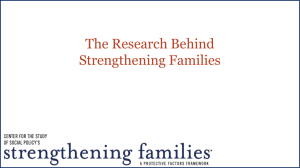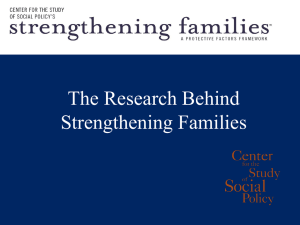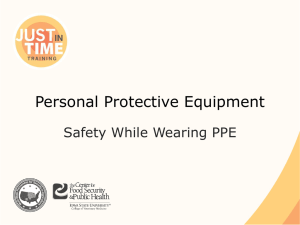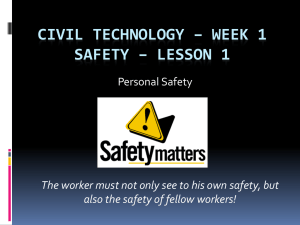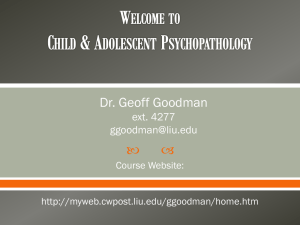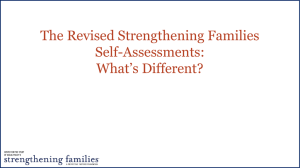Tools to Support Strengthening Families Implementation
advertisement
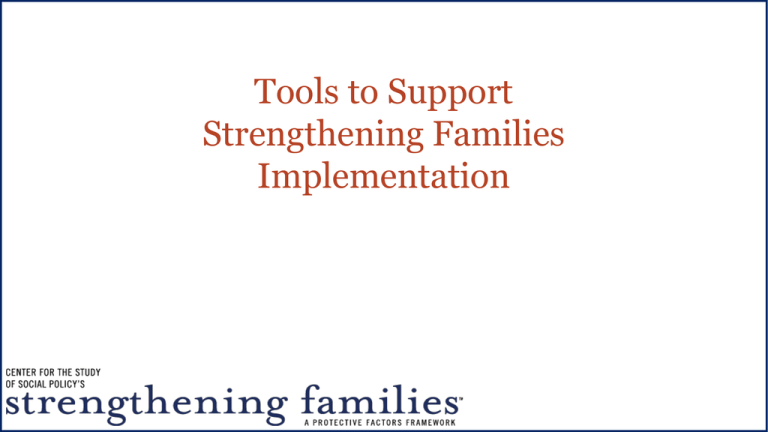
Tools to Support Strengthening Families Implementation Materials Describing the Strengthening Families Approach and the Protective Factors The Strengthening Families Approach and Protective Factors Framework: Branching Out and Reaching Deeper A synthesis of the ideas and research that further informs the Strengthening Families Approach and Protective Factors Framework http://www.cssp.org/reform/strengtheningfamilies/about/ the-research-behind-strengthening-families Research briefs about the protective factors http://www.cssp.org/reform/strengtheningfamilies/2013/SF_All-5-Protective-Factors.pdf Core meanings of the protective factors • Distills the information from the research briefs • Concrete definition of each protective factor http://www.cssp.org/reform/strengthening-families/2013/ Core-Meanings-of-the-SF-Protective-Factors.pdf Core slides about the protective factors – to include in your presentations Protective factors and everyday actions http://www.cssp.org/reform/strengthening-families/ 2014/SFProtectiveFactorsExpanded.pptx Additional slides for specific groups • For each protective factor, additional content, such as: – What we might see in families involved in CPS, and the caseworker role – What we might see in families touched by domestic violence – Concrete everyday actions for early care and education providers • Designed for use in orienting/training workers in those specific fields The Strengthening Families Logic Model The Strengthening Families Self-Assessments for Child- and Family-Serving Programs About the Self-Assessments • Key implementation tool for programs adopting a Strengthening Families Approach • Helps programs identify “small but significant changes” that enhance their ability to build protective factors • Created based on a national study of exemplary practice • Designed to be used flexibly and to lead you to a concrete action plan • Helps programs identify strengths & areas to focus • Not an evaluation tool but a tool for continuous improvement Four versions for different types of programs Everyday actions Organized around protective factors and the everyday actions that help families build them Five Protective Factor Sections + “Special Circumstances” Sections Special Circumstances Sections • Responding to Possible Child Abuse or Neglect (included in all four self-assessments) • Supporting a Child’s Transitions to School or Other Programs (Center-based ECE and Family Child Care tools) ECE Self-Assessments are Tiered • ECE Center-based – Baseline (i.e., any program) – Mid-level (i.e., more attention to parent engagement) – High (i.e., high attention to parent engagement and support) – Comprehensive Service Programs, for those centers that offer a comprehensive range of supports and services in addition to ECE (e.g., Head Start, family support centers). • Family Child Care – Baseline (i.e., simple day-to-day interactions), – Mid-level (i.e., more intentional focus on supporting and engaging parents) – High (i.e., reflect high level of focus on parent engagement and support— may be most appropriate or easiest to achieve for providers that are themselves receiving systemic support). Online Strengthening Families Data System Online Data System Suite of Tools http://www.mosaic-network.com/gemslive/cssp/ • Registration • Self-Assessment • Action Planning • Parent & Staff Surveys • Reports Parent and Staff Surveys PARENT SURVEY (Protective Factors Survey) •Measures changes in parental protective factors •Developed by the FRIENDS National Resource Center and the University of Kansas •Four national field tests to establish reliability and validity STAFF SURVEY •Looks at changes in staff attitudes, behaviors and skills •Developed by a collaborative team from 7 states—with review and input from evaluators in 3 states •Has not been extensively tested Tools to Measure Protective Factors Parent’s Assessment of Protective Factors • An individualized, strengths-based measure to assess the presence, strength, and growth of parents’ self-reported beliefs, feelings, and behaviors that are regarded as indicators of the Strengthening FamiliesTM Protective Factors. • It includes 36 statements to which a parent is asked to indicate the degree to which the statement is like the parent or what the parent believes. • It is intended for parents of young children who range in age from birth - 8 years old. • Parent’s Assessment of Protective Factors Parents’ Assessment of Protective Factors inventory yields valid and reliable results that can be used to: – (a) prompt specific shared conversations with a parent about building or reinforcing their protective factors; – (b) engage a parent as a partner in developing and implementing a service plan; and – (c) mobilize a parent’s resources to meet their unique, individualized needs in order to strengthen the parent’s capabilities and provide a family environment that promotes optimal child development and reduces the likelihood of negative child and family outcomes. The Protective Factors Survey (PFS) An evidence-based, (reliability and validity tested) 20-item caregiver-completed tool used to help measure changes in family protective factors. Provides feedback to agencies for continuous improvement and evaluation purposes. It is not intended for individual assessment, placement, or diagnostic purposes. Agencies should rely on other instruments for clinical use. Developed through a partnership with FRIENDS and The University of Kansas with input from multiple experts in the field, parent leaders, prevention workers, and hundreds of families. Being widely used in states across the country. http://friendsnrc.org/protective-factors-survey When PFS scores were high… Positive correlations Negative Correlations Effective coping was high Child abuse and neglect potential was low Physical and emotional health was good Stress was low Positive emotions were high Depression was low Optimism was high Negative emotions were low Pessimism was low Online Training Bringing the Protective Factors Framework to Life in Your Work • Online training to support • 7 courses, implementation of the each about Strengthening Families™ 2 hours in length Protective Factors Framework o Introduction to the Framework (also useful as a stand-alone in multiple settings orientation) • Systems may use for o A course on each of the 5 awarding CEUs, credit Protective Factors • Free of charge o A wrap-up course that moves users from knowledge to action Find at www.ctfalliance.org/onlinetraining Contact onlinelinetraining@ctfalliance.org Café Conversations Taking a Parent-to-Parent Approach • Community and Parent Cafes • Reframing using parent friendly language • Using a World Café Approach to build a comfortable, parent-led space • Tying to a larger parent leadership and engagement infrastructure • Harvesting to inform systems and structures The basis: World Café • A method for “engaging people in conversations that matter” • Includes a set of design principles and a basic strategy for engaging people in small-group conversations • Cafés designed for parents to build protective factors are just one of many ways the World Café method has been adapted and used around the world • For more: http://www.theworldcafe.com/about.html Parent Café • Developed by parent leaders as part of Strengthening FamiliesIllinois in 2007, and is now housed with Be Strong Families • Provide a safe, non-judgmental opportunity for parents and caregivers to: build their protective factors, talk about what it means to keep their children safe and families strong and build parent leadership • Parent Café training, a fidelity framework, “Parent Café in a Box” and evaluation tools are available from Be Strong Families at http://www.bestrongfamilies.net/build-protectivefactors/parent-cafes/ Community Café • Developed by parent volunteers in Washington State and is now supported by a volunteer Community Café Leadership Team • Designed to respond to community needs and concerns as well as reflect the local community culture • Café questions may or may not directly address the protective factors, but hosts use the Protective Factors Framework as a guiding framework • Through Community Cafés, parents and caregivers build their leadership, resilience, social connections and other protective factors • Leadership Team offers an online orientation kit as well as orientation and guidance at http://thecommunitycafe.com/
